FC Köln are what’s called a “Fahrstulmannschaft” in Germany.
Fahrstuhlmannschaft, translated into English, means “elevator team”, describing a team that constantly alternates between the Bundesliga and the second division, the 2. Bundesliga.
With seven relegations, Köln have the third most relegations in Bundesliga history, but their six promotions are also the third-best in German football.
Last season, it was time once again.
After five consecutive seasons in the German top flight, Köln scored only 27 points and five wins out of 34 games, getting relegated.
Furthermore, UEFA handed the club a transfer ban for an irregular transfer of a minor, so they could not sign or register players to their squad until December 31st, 2024.
With key departures, like Jeff Chabot, who left for UEFA Champions League football at VfB Stuttgart, the club signed former Red Bull Salzburg manager Gerhard Struber to their project.
The 47-year-old Austrian was fired from his coaching gig at Red Bull last season.
He started his coaching career as a youth coach and took on a new challenge to bring his brand of football to Germany.
While the start of the season looks rather disappointing for a team like Köln, Struber’s men are playing very well.
Köln are currently allowing the fewest shots and the second-lowest amount of xG against in the league.
They are also playing the most passes in the league and have created by far the most shots and expected goals in the league so far this season, all of that with the youngest team in 2. Bundesliga.
But Köln are underperforming compared to their statistics, conceding 20 goals out of 14.28 xGA and scoring only 25 goals out of their 220 shots and 25.4 xG.
While the team is playing well, Köln lacks two things: A bit of luck against the ball and a player consistently converting the chances they are creating.
With Christmas coming soon and the transfer ban being lifted in January, we will take a look at players who could and should be on Gerhard Struber’s wishlist to improve his team’s efficiency for the coming months in this recruitment analysis.
Gerhard Struber Style Of Play & Developing A Profile
To evaluate potential new signings, we first have to establish what Köln have done well so far under Struber, what playing style they are using, and what a potential new striker needs to do for the team.
Struber started the season with a 4-4-2 diamond formation, but after defensive struggles, he changed his ways and had his team line up in a 3-4-1-2 formation in the last three games.
Since making the change, the team has not conceded a single goal.
Things stayed the same up front, with Struber preferring a two-man partnership in his attack.
This is not just the typical Red Bull way.
Struber’s teams also needs to be present in the attacking centre of the pitch to create quick vertical options in the passing game and to be present in the box for crosses.
While Red Bull coaches usually don’t value possession, Köln are currently still in fifth place in possession per game because the team is simply the favourite against most smaller teams in the league as a freshly relegated side.
Köln have created 220 shots so far this season, which is by far the most in the 2. Bundesliga.
Let’s take a look at how they are creating these types of shots.
FC Köln Shot Assists Map
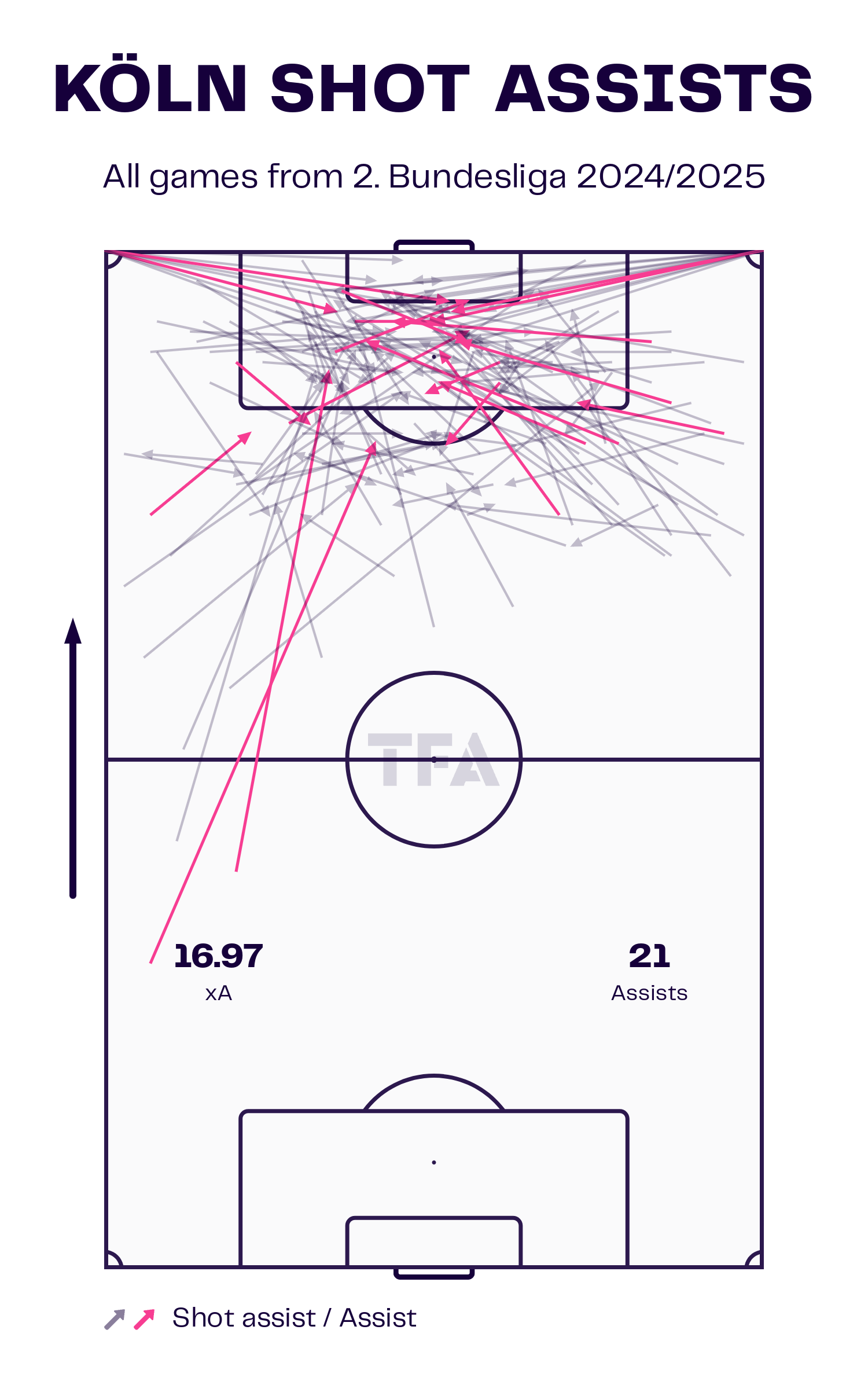
In the graphic, we can see all the shot assists of Köln in the 2. Bundesliga season so far.
As per the graph, the team has many shot assists, which was expected.
However, we can also see that they create their shots from a variety of positions, with goals coming from different settings like corners, long passes, and crosses.
Still, there is a pattern of crosses and passes from the half spaces and wings into the box that lead to shots, but most of these shots do not end up as goals.
This needs to be the area Struber needs to improve his team in quickly.
FC Köln Crossing Zones Map
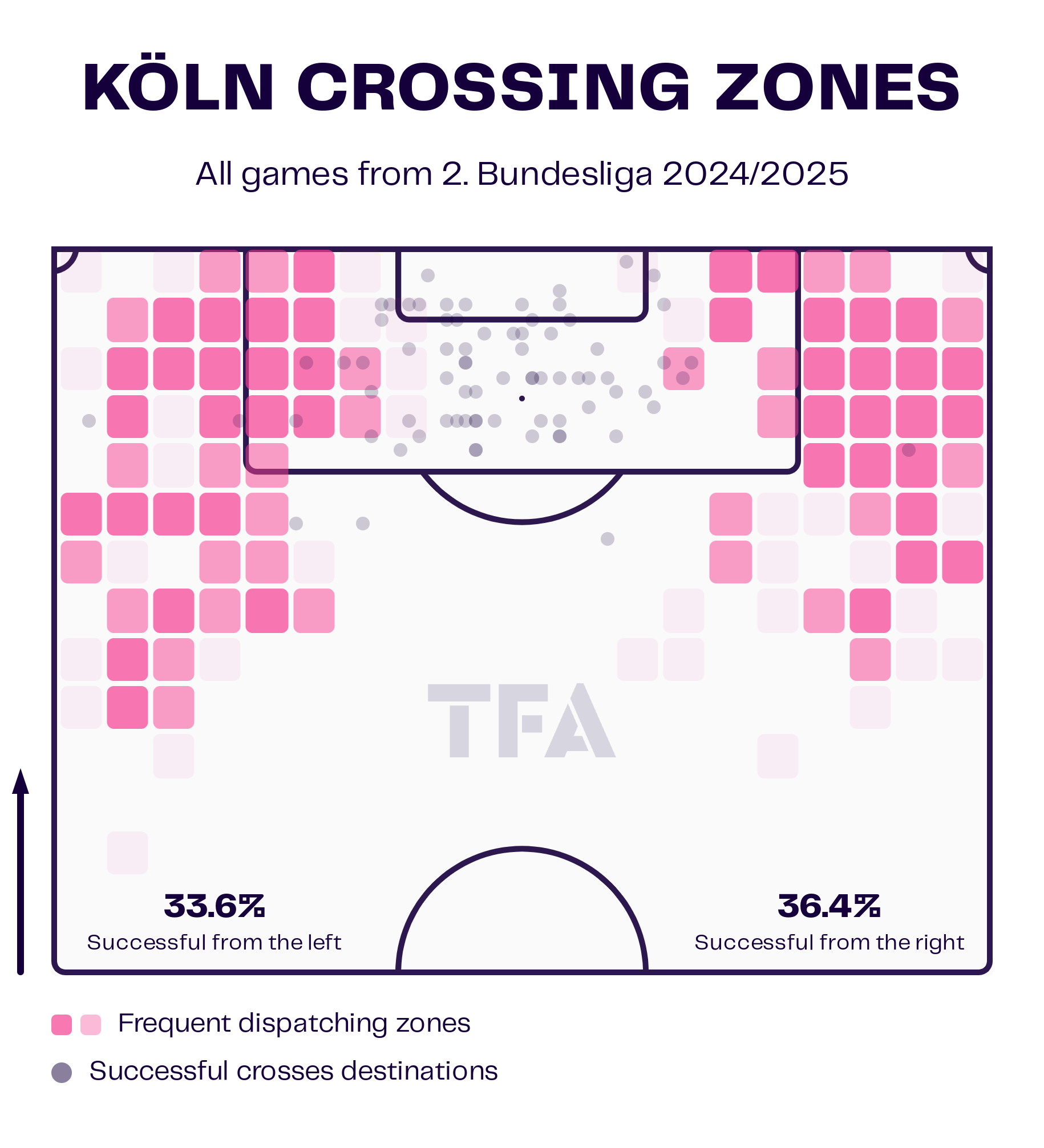
Looking at the crossing zones, we can see that Köln are able to cross from different positions on the pitch.
On the right side, the zones are rather clear, and the crosses are also successful to a good degree.
On the left side, the crossing zones are spread out wider, and the success rate is slightly lower.
The players playing there explain this because most of the crosses from the left side come from Leart Paçarada, a left-back who likes to play crosses out of the half-field.
Another takeaway from the crossing chart is that Köln managed to find many players in the centre of the field around the penalty spot.
This means that most of their crosses are well-placed and end up in good spots, but the team can not capitalise on their good chances.
With 223 crosses in 12 games, Struber’s team ranks fourth in terms of total number of crosses this season in the 2. Bundesliga.
FC Köln High Regains Map
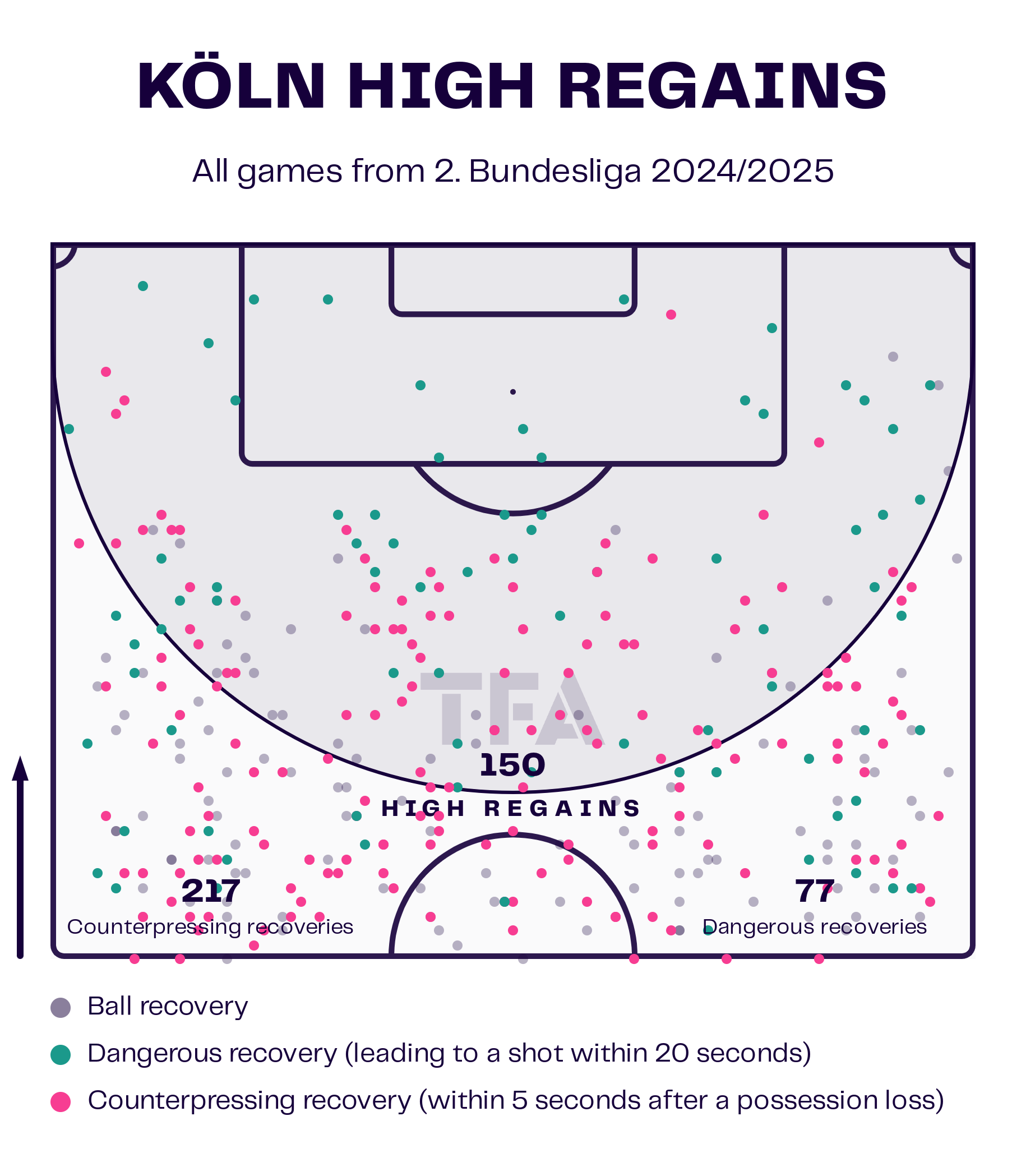
Here, we can see all the recoveries of Köln in the opposing half of this season so far.
With 150 high regains and 217 counter-pressing recoveries, the team is incredibly aggressive against the ball.
It plays with a high intensity and tries to win back the ball as quickly as possible.
This also means that the strikers have to work hard against the ball, trigger and direct the press, engage in the counter-press at all times, and always play at a high speed against the ball.
The counter-press is probably the most important tactical measure Struber has implemented on the team this season.
With 77 dangerous recoveries, the team consistently creates goalscoring opportunities out of recoveries and transitions well between possession and out-of-possession.
Combining all of what we have found out so far, we can see that Köln is creating a lot of good goalscoring opportunities with its high volume of crosses but lacks the ability to finish off attacks successfully.
If we are talking about a Red Bull coach like Gerhard Struber, we obviously have to talk about the play against the ball.
Struber has his team play a very high attacking press most of the time, and Köln has a great counter-press as well, which is usually expected from teams with this coaching background.
Putting all these things together, we can create a profile for a striker that can help 1. FC Köln in the second half of the season.
Firstly, he has good finishing, especially after crosses and on the counter after recoveries in the opposing half.
He has also overperformed in regard to his expected goals.
Secondly, a good work ethic against the ball, being able to play in a high-pressing line, and being quick and willing to engage in the counter-press are also important.
Thirdly, with the squad being the youngest in the league, the player should not be a young talent with no experience at the senior level.
Last but not least, the player needs to be good enough to have an instant impact at the level of play in the 2. Bundesliga.
In the upcoming paragraphs, we will examine five players who fit that profile and could be interesting to Köln and Gerhard Struber in the winter transfer window.
Shon Weissman – A Potential Reunion?
During his time at Red Bull Salzburg and their academy and farm team, FC Liefering, Gerhard Struber coached many talented attacking players, including Karim Konaté, Oscar Gloukh, Sekou Koita, and even Dominik Szoboszlai.
The attacker that worked the best for Struber was someone else.
However, the striker still scored the most goals for Struber despite being coached in only 20 games at Wolfsberger AC in the 2019/20 season.
Shon Weissman joined the Struber-coached team in the summer of 2019, and the season quickly became a miracle for the club and the Israeli striker.
In Struber’s two-striker system, Weissman played the season of his life, scoring 18 goals in 20 games under the now-Köln coach.
After Struber left mid-season, he scored 17 more goals in the last 20 games for WAC before moving to Valladolid and Granada in Spain.
Weissman did not just prove himself at Wolfsberg; he also got Real Valladolid promoted back to La Liga in 2022 by scoring 20 goals for the team in the Segunda that season, showing that he is the right man for situations like the one unfolding in Köln.
Let’s take a deeper dive into Weissman’s abilities.
While he is only 1,74m tall, he still is an incredibly physical player, constantly using his pace to his advantage for runs behind the defensive line in counterattacking situations and finding space in the box.
Shon Weissman Shots Map
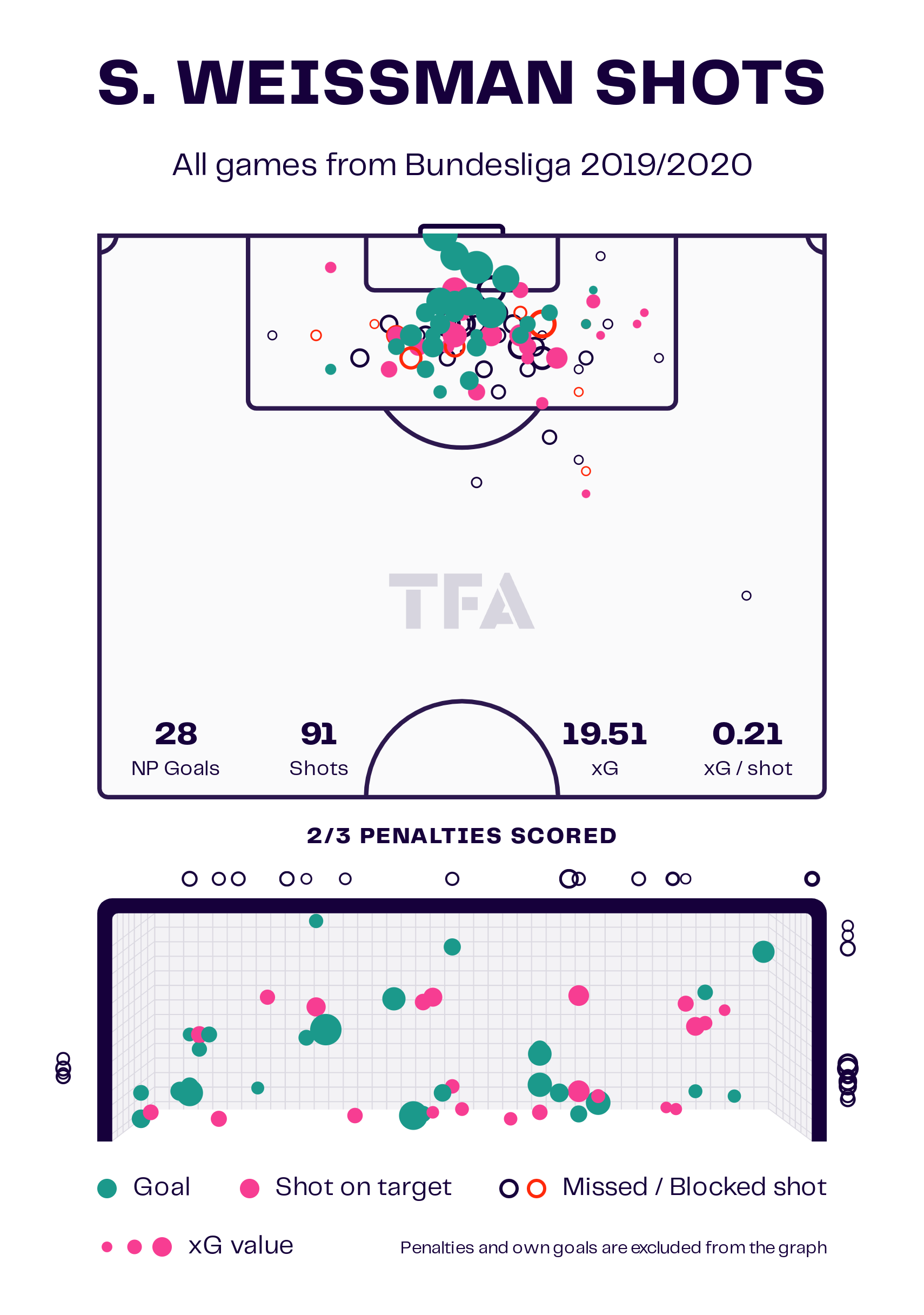
Looking at his shot map from his season at Wolfsberger AC, it is no wonder that Weissman worked incredibly well under Struber.
Weissman can always bring himself into position in the six-yard box, especially around the penalty spot, where Struber’s attacking principle creates the most goalscoring chances.
Despite his size, he is a clinical finisher in the box, not only with his right foot but also his head.
While he won’t win a lot of direct aerial duels, Weissman is great at getting in front of defenders for crosses and finishing with his first touch.
Another strength of the 28-year-old is his work against the ball.
Weissman always plays high intensity, directing the attacking press and forcing defenders into obnoxiously physical duels with his pace and low point of gravity.
In the counter-press, the Israeli shows great reaction times after losing to work against the ball instantly and is extremely willing to go the distance against the ball.
Shon Weissman High Regains Map
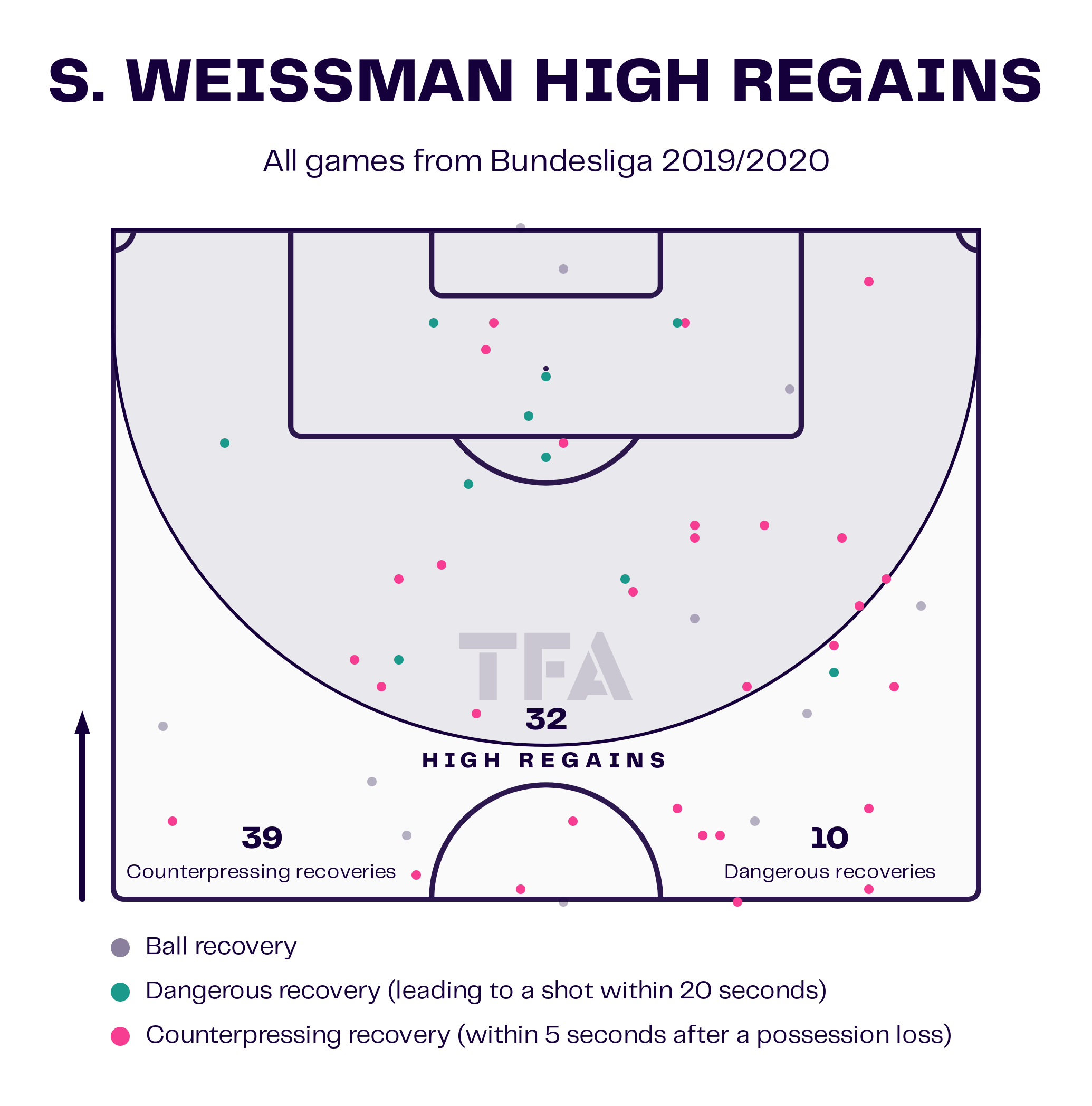
We can see Weissman’s high regains in his season under Struber at WAC here.
With 39 counter-pressing recoveries and 32 high regain of possession, he is eager to work against the ball and successfully recover it in the opposing half, especially in and around the box in counter-pressing.
Weissman is also great at converting these recoveries into goalscoring opportunities.
He has 10 dangerous recoveries himself and multiple goals scored out of high regains of his teammates under Struber.
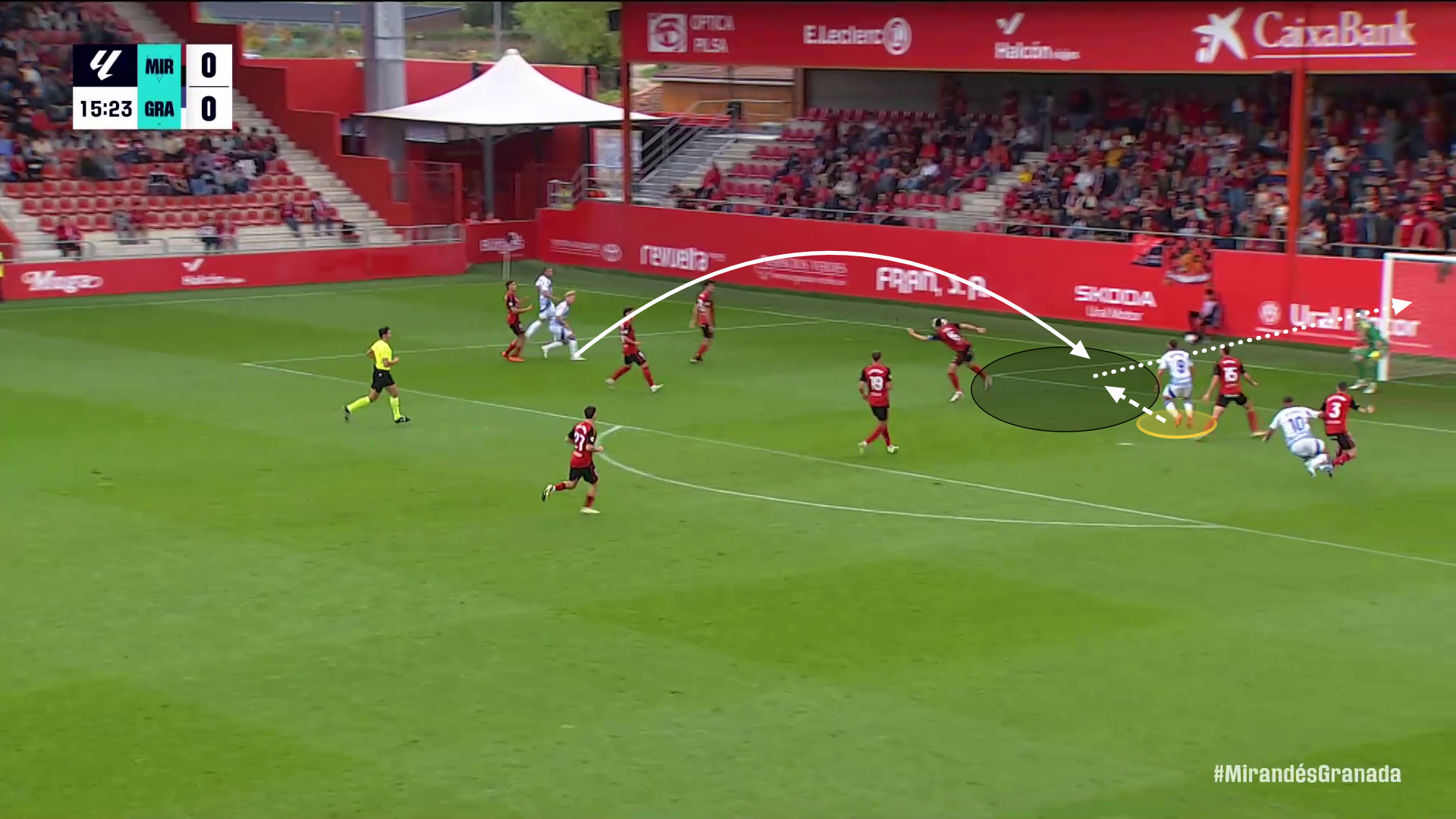
If we examine a typical situation for Weissman, we can see his lone goal for Granada this season.
Weissman moves into the box quickly after a recovery for his team, finding space between the two centre-backs.
He then moves in front of his marker so he can always get to the ball before his defender has a chance, using his pace to get into the space where the ball will come.
He acrobatically finishes with his left foot to the near post, leaving the goalkeeper no chance of saving the shot.
This situation occurs a lot for Köln this season, and Weissman knows how to capitalise on it.
While there is no question about Weissman’s tactical fit under Struber, the Israeli is not in great form currently, having scored only five goals in the last two years.
But with his contract running out in the summer anyway, Köln might be able to pick him up for a small fee.
A reunion could be beneficial for both sides.
Weissman knows what Struber expects from him.
He is a very good fit for the Austrian coach’s vision of his team’s play and has proven himself able to work well in that system.
For Köln, Weissman could be a low-risk option as an experienced striker with a knack for scoring goals in areas where they are currently struggling.
With a familiar coach and playing style, I am sure that Shon Weissman could find his form again quickly and be the goal-scorer Struber is desperately looking for.
Koki Ogawa – Making Use Of Your Environment
The second striker we will examine is currently with the Japanese national team.
He scored seven goals in eight appearances and is a key player in his team’s World Cup qualifiers.
Koki Ogawa has been one of the revelations of the 23/24 Eredivisie season.
He scored 11 goals for NEC Nijmegen after the team loaned him out of the Japanese J1 League‘s relegation battle.
Ogawa never played abroad before making his debut with NEC Nijmegen in the Netherlands at the start of last season at the age of 26.
The Japanese striker did not take long to take a lead role in Nijmegen.
He scored in his first two appearances and is currently averaging 22 goals and two assists in 49 appearances for the Dutchmen.
This season, Ogawa has scored five goals in 11 league games and a brace against PEC Zwolle in the cup, bringing his total to seven goals in 12 games.
Ogawa is a rather tall striker, standing at 1.86m, but he is not physically imposing and can still hold his own in every duel he takes.
Ogawa’s strengths lie in his work ethic, ball security, positioning, and finishing.
Especially against the ball, he consistently shows a great work ethic.
He covers a lot of ground and space, always fulfils his tactical tasks, and helps his teammates wherever possible.
In attack, Ogawa has elite spatial awareness, which allows him to make quick and accurate decisions about his positioning.
He times his runs exceptionally well and is always finding the blind spots of the centre-backs in the box, being able to get open in the box often.
This results in not many shots, but the shots he takes are of high quality, which allows him to be a very efficient player so far this season on a team that has struggled offensively for the majority of the season.
Koki Ogawa Shots Map
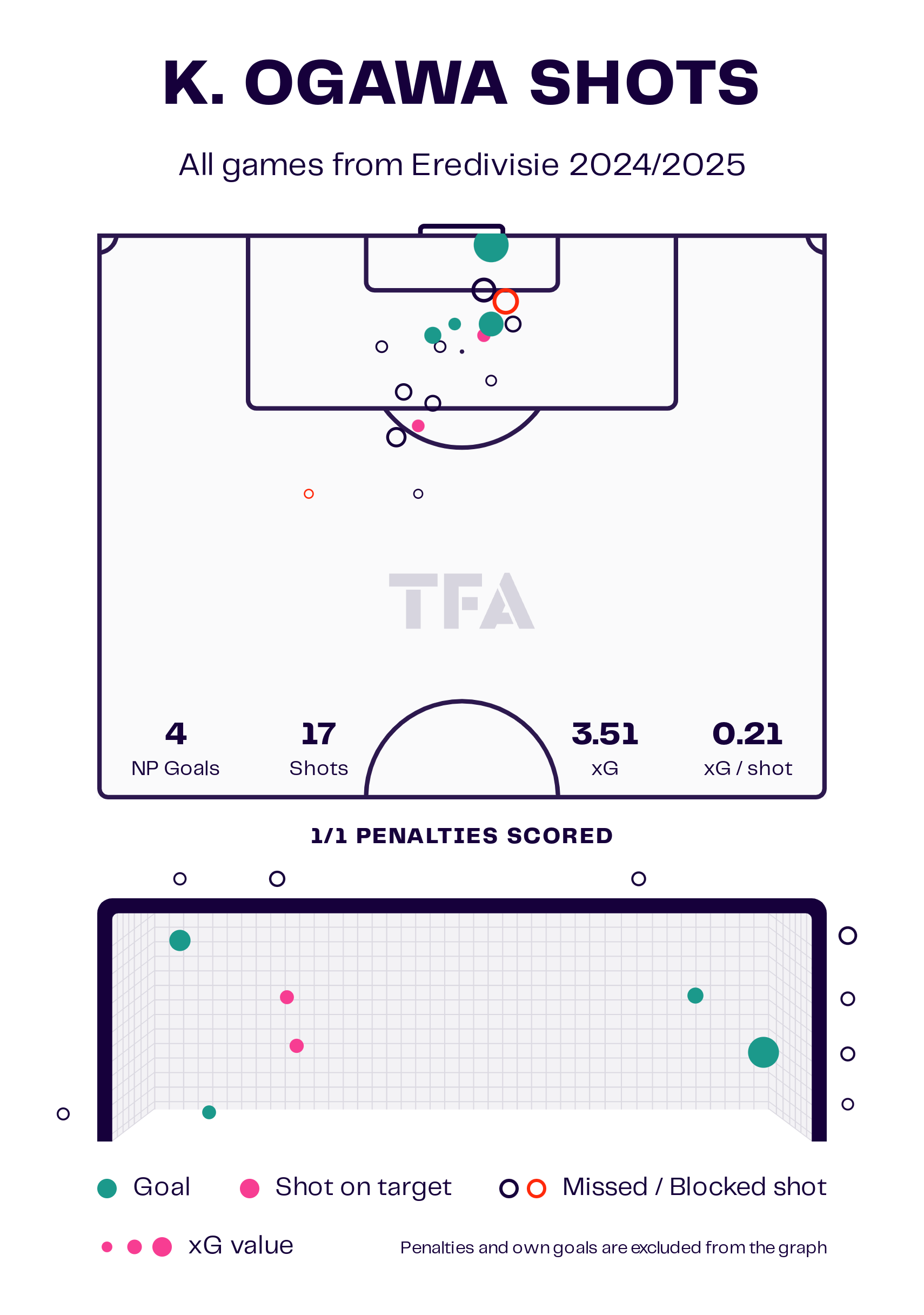
Taking a look at his shots, we can see two things.
For one, Ogawa can also find many opportunities around penalty spots.
This is a direct result of his good positioning and movement in the box, which should blend very well with the playing style of 1. FC Köln under Struber tactics.
Secondly, if we examine the placement of the shots this season, we can see that Ogawa is great at placing his shots near the post.
Even opportunities with a low xG-value are placed very well and are hard to save for opposing goalkeepers, making Ogawa a threat at any time.
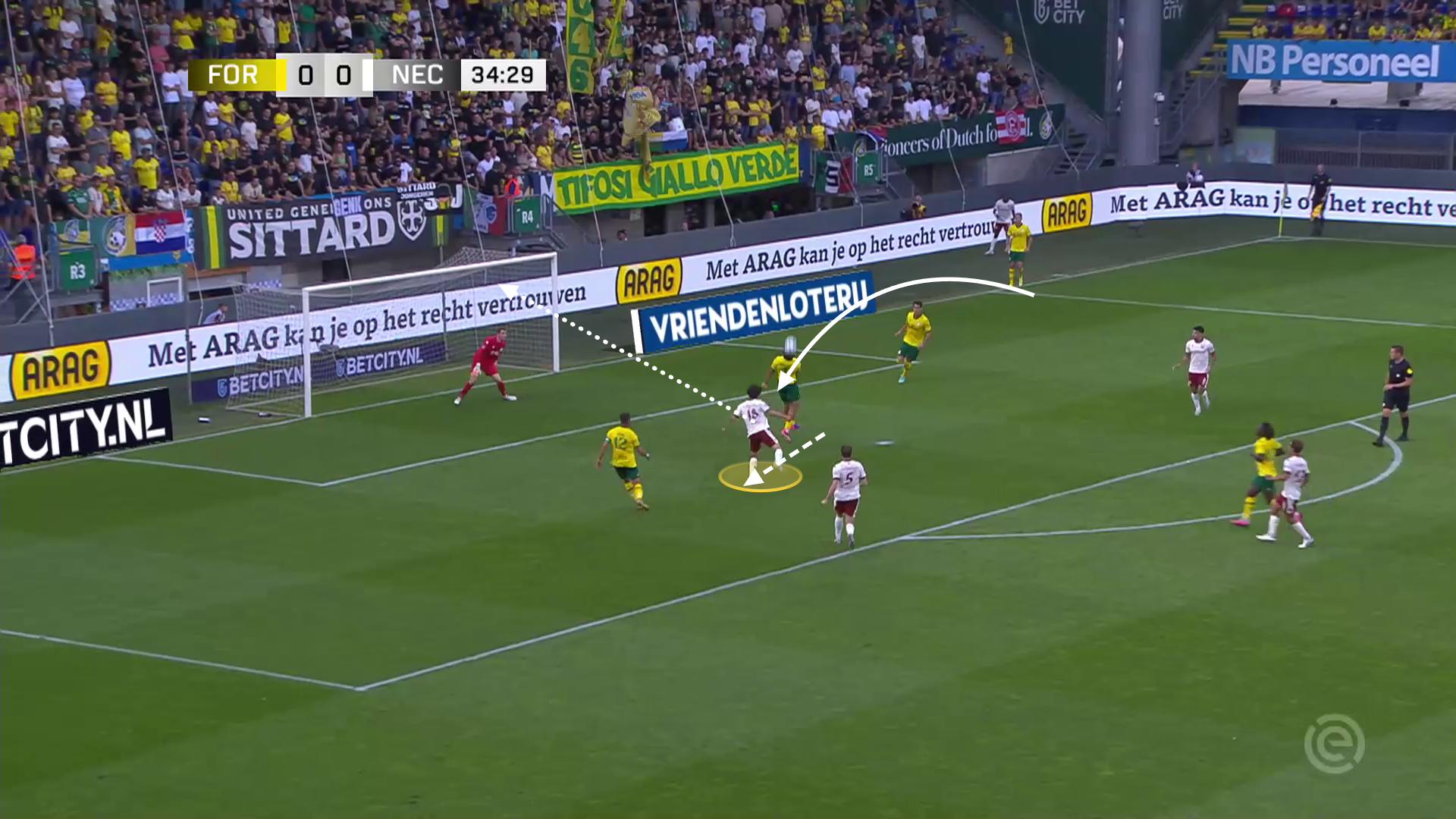
Here, we can see Ogawa’s goal against Fortuna Sittard this season.
NEC Nijmegen is creating a good crossing opportunity on their right side, but they lack presence in the box, so Ogawa is in a 1v3 situation.
He understands the defenders’ movement to cover their assigned space and uses it to his advantage, finding space between two centre-backs and finishing the shot with impressive balance.
While Ogawa has shown great quality and goalscoring instincts at Nijmegen, Japanese players are always hard to integrate into your squad.
Here, Köln and Struber can make use of their environments.
Nijmegen is a town right at the German-Dutch border, meaning that if Ogawa can integrate well there, he should be able to integrate into a very similar culture in the city of Köln.
Düsseldorf is right next to Köln, and Düsseldorf has a huge Japanese community.
The surrounding clubs have used this community to help Japanese signings in the last couple of years, like Ao Tanaka for Fortuna and Yuya Osako for Köln.
Using their surroundings, Struber and Köln could easily find a very efficient and experienced striker in Koki Ogawa this winter.
Rayan Philippe – Don’t Look Further Than Your Own League
So Köln is looking for a striker that guarantees them goals in the 2. Bundesliga for the second half of the season, so why not look at what players have performed well in the first half of the season and are attainable for the club?
While there are very good strikers in the 2. Bundesliga this season, players like Isac Lidberg from Darmstadt 98 or Ragnar Ache from 1. FC Kaiserslautern are not realistic transfer targets for Köln this winter, as the club is still struggling with financial problems from the Covid years.
However, one extremely successful player plays for a much smaller club and is in a contract year, meaning the price should be rather low: Rayan Philippe.
With seven goals and one additional assist, the French striker has been directly involved in 57% of his team’s goals, Eintracht Braunschweig, this season after already scoring eight goals and assisting five in the last 18 games of last season.
The pacey Philippe has had an exciting way into professional football and is not a traditional striker.
Philippe’s career stopped after an impressive youth stint at FC Metz and becoming an under-20 international with the likes of Tchouameni or Maxence Lacroix.
He did not break through into the first team at Metz, and even a loan spell to AS Nancy was disappointing.
Philippe, therefore, took a different route, moving to Luxembourg, single-handedly carrying Hesperingen to their one and only championship with 32 goals and 27 assists in 30 games, playing as a winger or an attacking midfielder.
After his incredible pace, this is one of Philippe’s biggest strengths.
He has a great area of action, consistently moves all around the pitch, and gets the defence to move, but he still cannot grasp him.
Combine this movement with the goalscoring instincts and finishing of a talented striker with the creativity and technical brilliance of an attacking midfielder, Philippe is currently playing amazing in Braunschweig’s 3-4-1-2 system, making him a perfect fit for what Struber is doing right now as well.
While Philippe does not have a significant presence in the box or aerial or heading ability, his wide range of actions and his pace and determination in counterattacking situations make him an excellent fit for Struber’s idea of football while still providing excellent finishing ability.
Rayan Philippe Shots Map
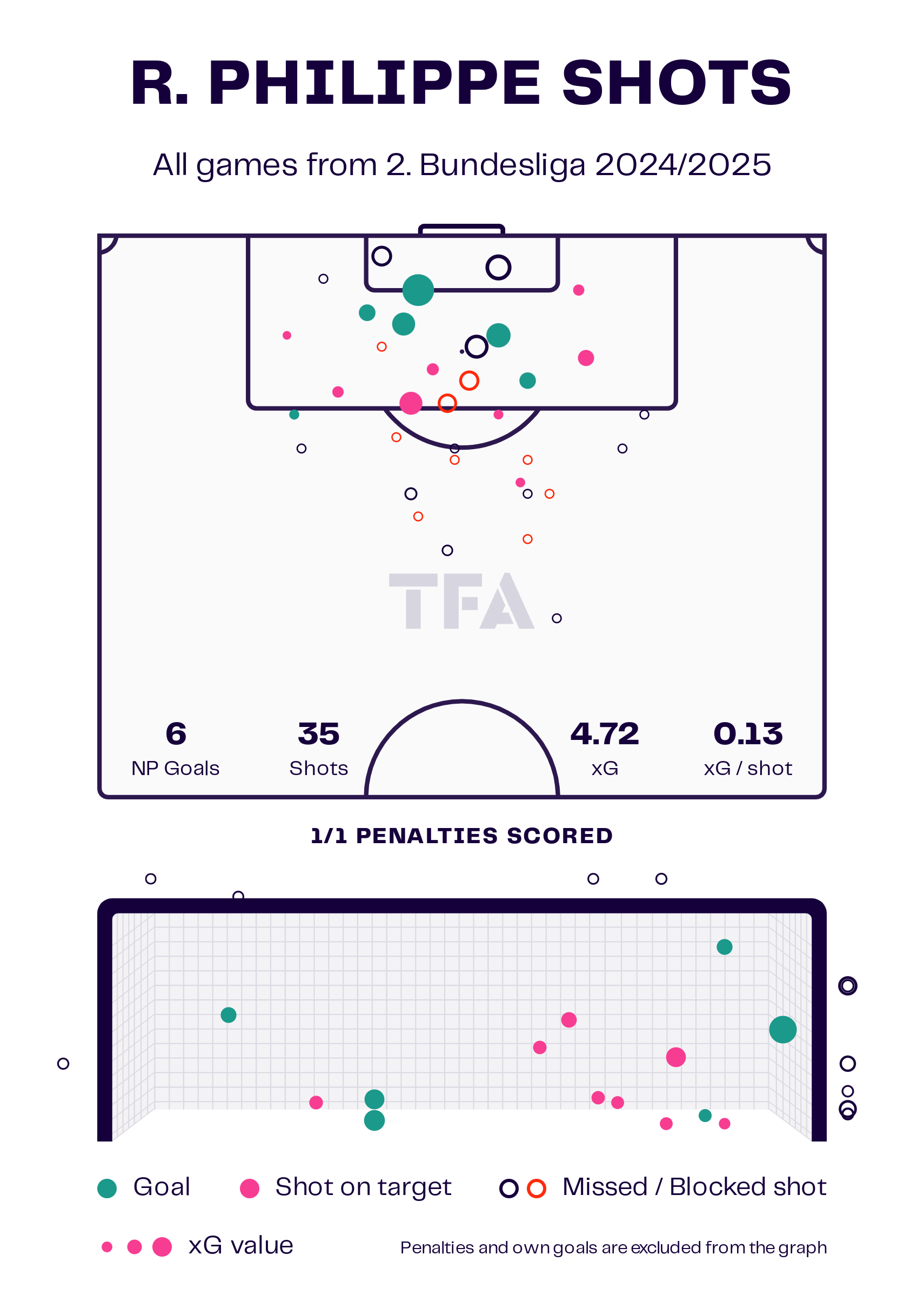
Looking at his shot map, it becomes evident that Philippe is not a typical striker and a very wild type of player, shooting from everywhere on the pitch and a lot from outside the box.
Still, he is also finding his spots in the box, not just in the centre of the field but all around.
Köln’s ability to create many shots and Philippe’s ability to finish from anywhere on the pitch make this combination potentially lethal for opposing teams.
His work against the ball is also very good.
After not making the squad multiple times at the beginning of last season because of his defensive work, Philippe worked hard to become a better player and help his team in the relegation battle.
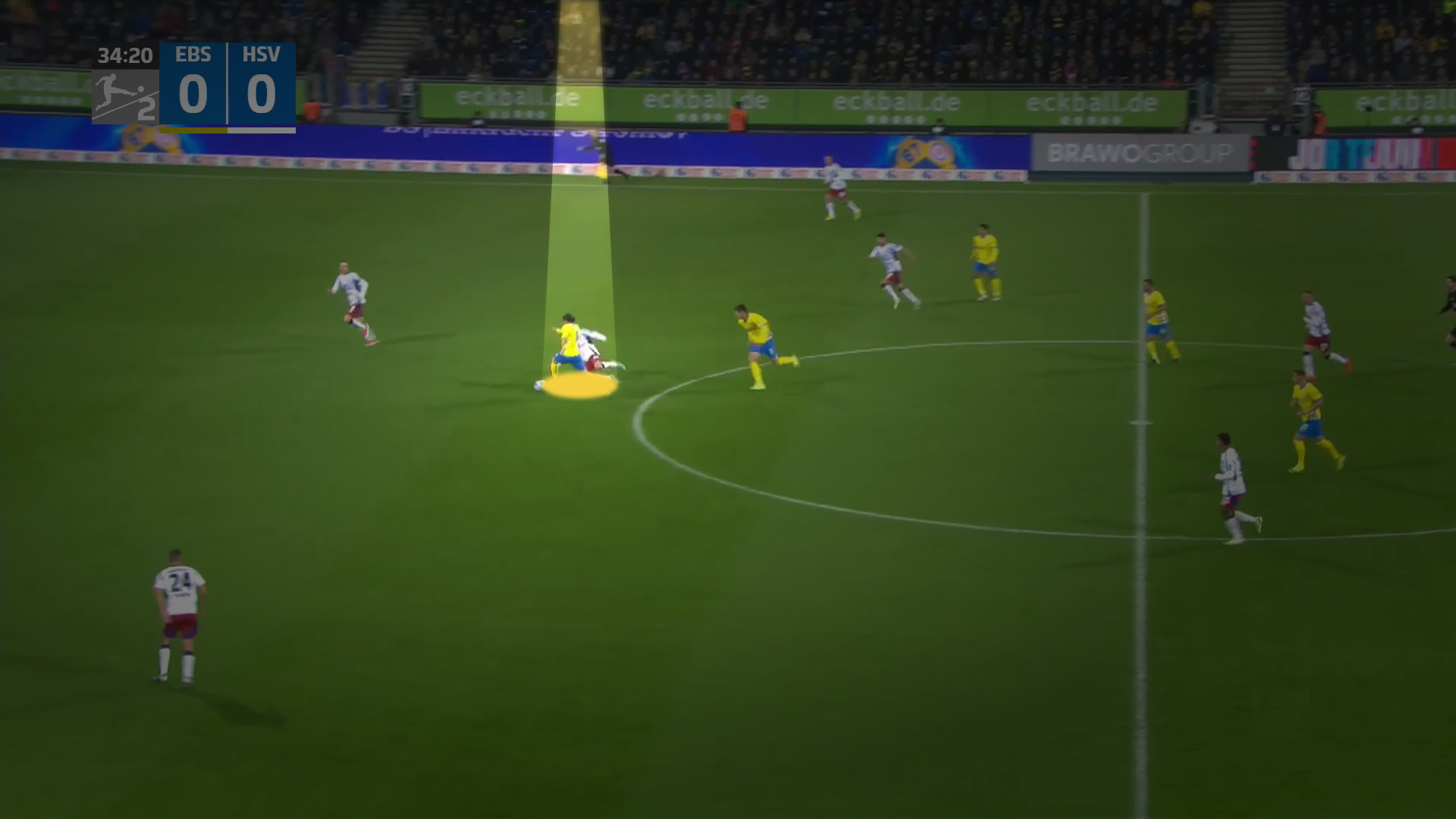
Here, we can see a situation in the game against Hamburger SV, where Braunschweig was the underdog.
Philippe and his striking partner constantly covered a lot of ground, waiting for their chance to trigger the press.
After the HSV-holding midfielder makes a mistake, Philippe instantly sees his chance.
He aggressively presses after the mistake and manages to win the ball.
We can now see Philippe’s biggest strength: he is a menace on the counter.
He does not hesitate at all.
Instantly, he uses his pace and dribbles towards the last remaining HSV defender in range.
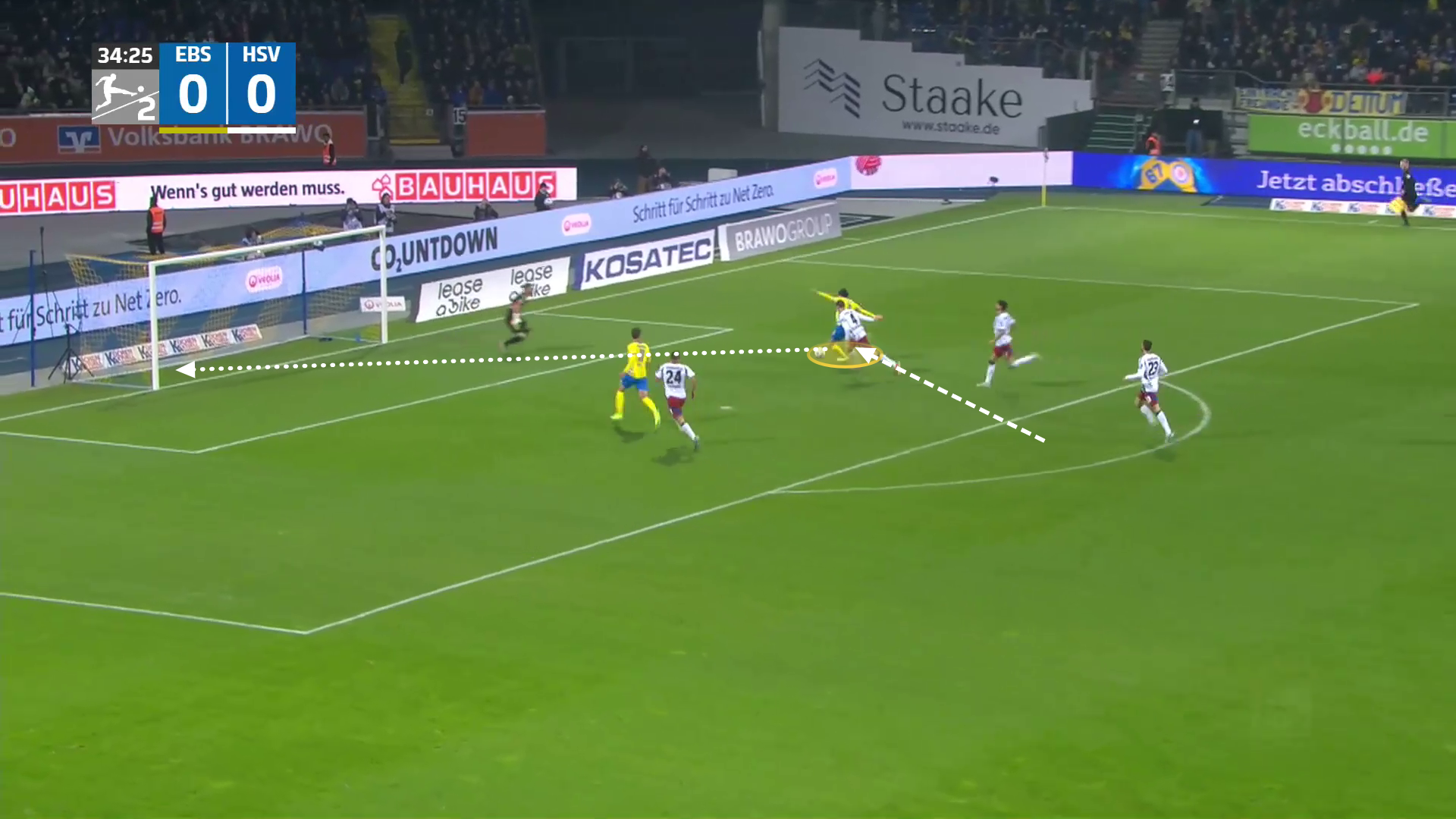
He takes on the defender, easily gets past him with his pace and technique, and moves outwards to open a shooting window.
He then pulled the trigger at the right time, scoring the game’s first goal.
This would result in a huge upset for Braunschweig over HSV, with Philippe scoring a brace.
While Philippe is not a traditional striker, his unique playing style offers his team many opportunities for attacking play.
With his pace, ability to always be a threat on the counter and in transition, and excellent shooting technique and finishing, Rayan Philippe has proven one of the best strikers in 2. Bundesliga over the last 12 months and could provide Gerhard Struber and his team with a special spark.
Mikkel Kaufmann – Unhappy Danish Dynamite
Mikkel Kaufmann is a very special case of a player.
Kaufmann, who left FC Kopenhagen in 2021, is playing his fourth season in Germany at the age of 23.
What’s so special about that?
He is on his fourth team right now.
After a mediocre loan to HSV, he had a great loan spell at Karlsruher SC, moved to Union Berlin, where he didn’t get enough playing time and now moved to 1. FC Heidenheim, where he does not play a lot as well.
With not even 200 minutes of Bundesliga for Kaufmann, he could be on the verge of looking for his fifth club in the last 3,5 years.
Kaufmann is a physical specimen.
At 1.89m and 90kg, the Danish striker is still one of German football's fastest and most agile players.
In his loan spell at Karlsruhe, he proved himself to be one of the top strikers in the 2. Bundesliga, scoring 10 goals and assisting eight more.
This resulted in his transfer to Union Berlin after half of the Bundesliga was willing to sign him.
What makes Kaufmann incredibly interesting is his combination of size and speed.
Not many players can move like him at that size, and his coordination and footwork are still elite at high speeds.
He is kind of a poor man’s Erling Haaland, with incredible power and speed, making him hard to defend in the box and on counterattacks.
Kaufmann’s best performances came as part of a two-man striker partnership in Karlsruhe, where he contributed 15 goals in his last 17 games at the club.
During that time, KSC was the most feared counterattacking team in the country, and Kaufmann was the main reason for that.
Not only is he elite on the counterattack, but like his comparison, Haaland, he has a very powerful shooting technique, allowing him to finish attacks off with a bang.
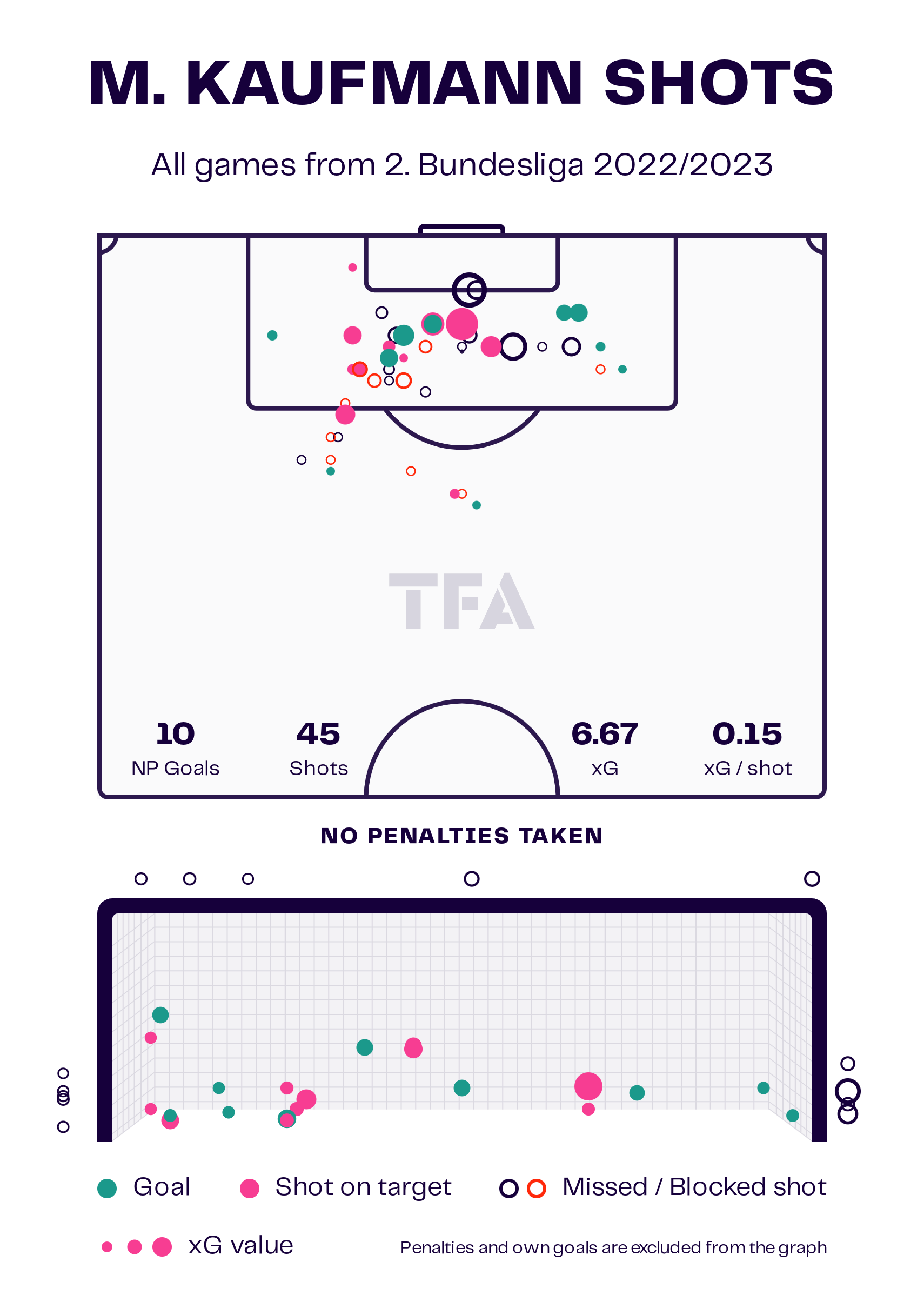
Taking a look at his shot map from his last season in 2. Bundesliga, we can see that he was able to get off a lot of shots and massively outperform his xG-value.
He is a threat from anywhere in the box, but especially from the right side, where he managed to convert many chances with a relatively low xG-value.
He also brought himself into good positions right in the centre of the box as well, which is where he needs to perform for Struber if he wants to be the new main factor for Köln.
This is also where Kaufmann’s biggest criticism lies: While he outperforms his xG handily in situations where he is not expected to score goals at all, he struggled with converting big chances right in the middle of the box, as seen in the shot map.
His technique sometimes lets him down if he has too much time to think about what he should do, resulting in bad shots in great situations and bad passes on the counter.
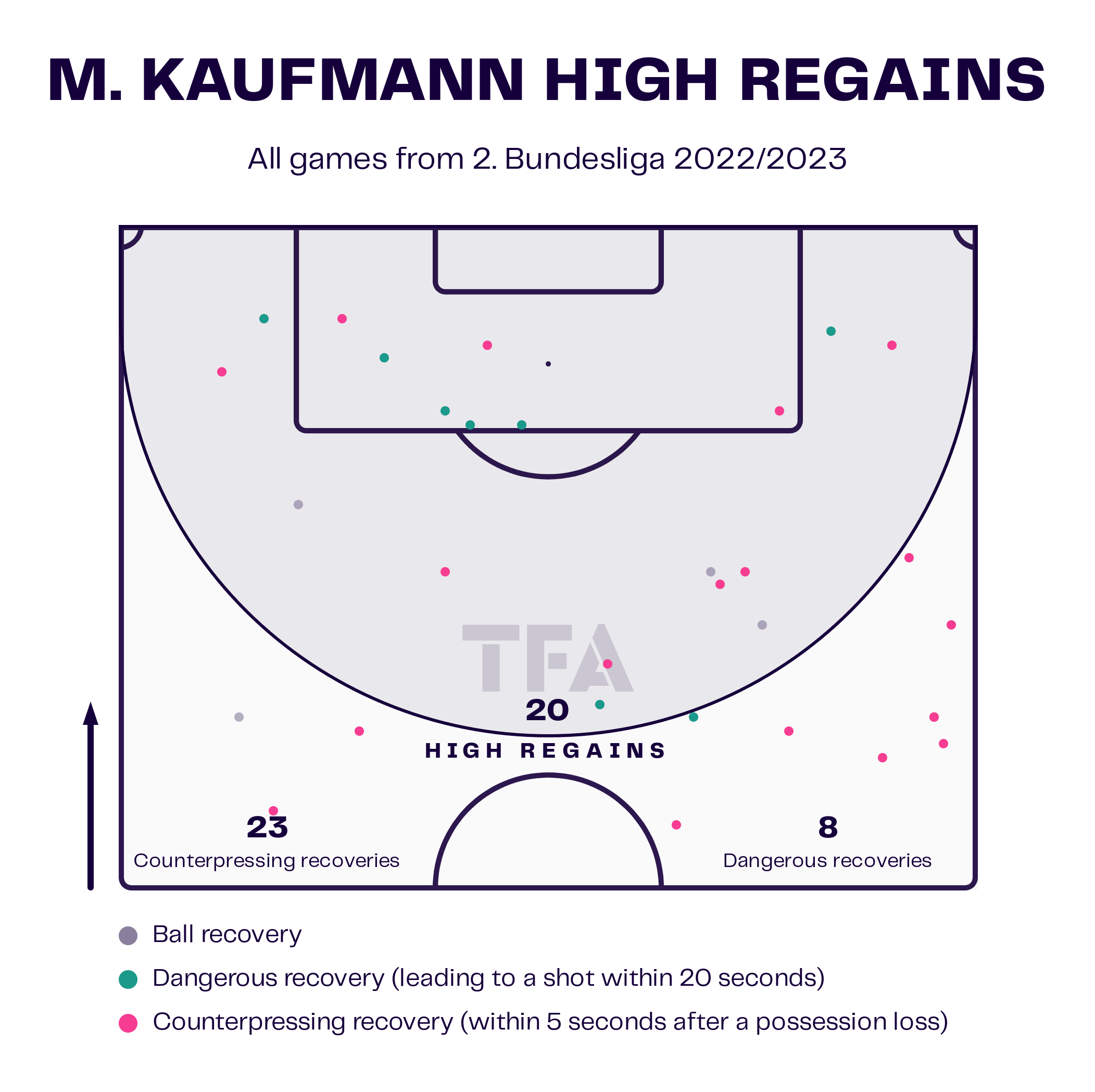
Looking at what Kaufmann does well against the ball, we can see a wide range of defensive actions and many recoveries in the counter-press.
He is also able to create many high regains and create goalscoring chances off of them, which is very important for a new Köln striker.
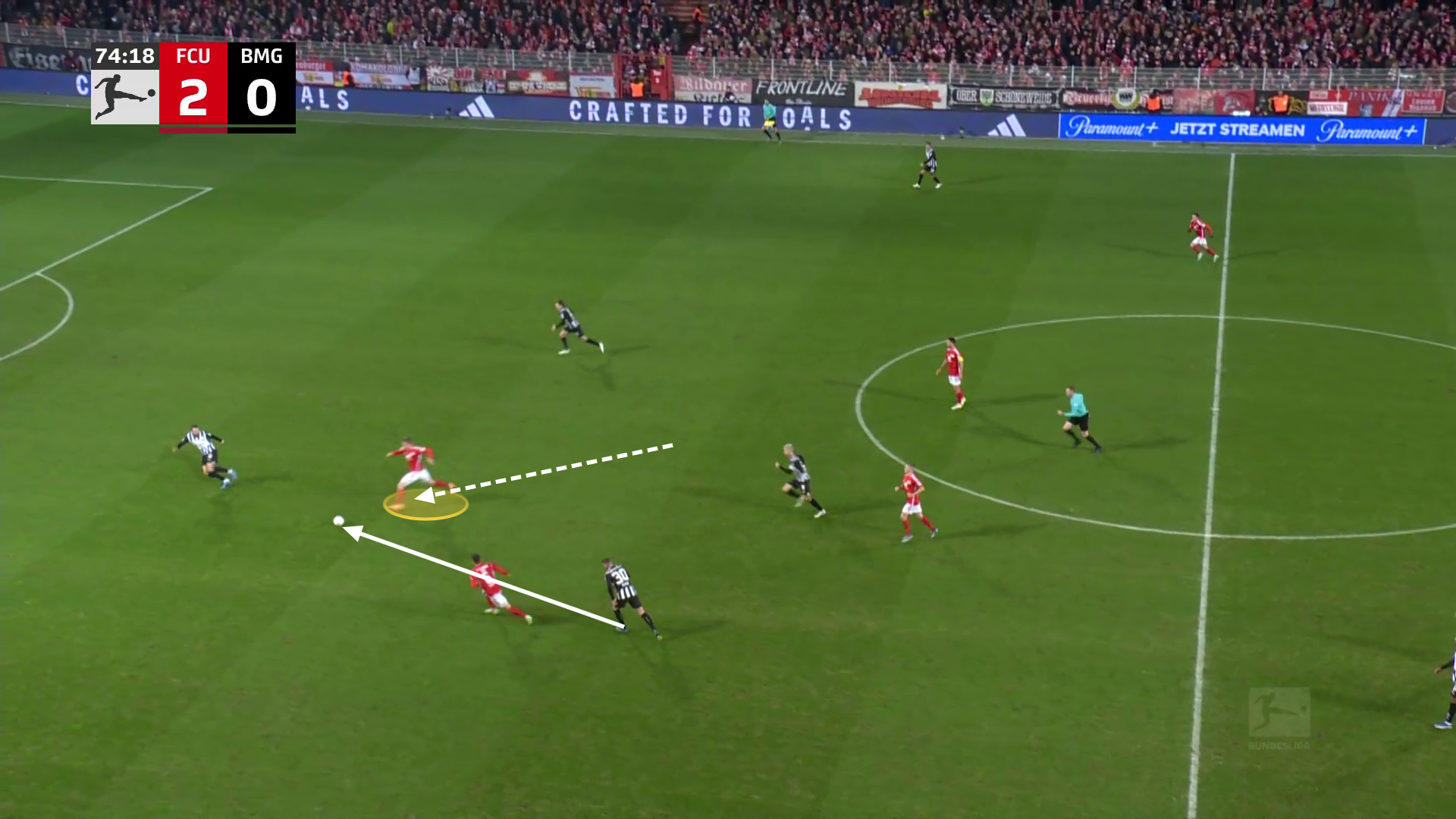
Here, we can see a typical Kaufmann situation.
Union managed to exert pressure with their attacking press, and Kaufmann was ready to pounce on the mistake, recovering the bad pace with his elite pace.
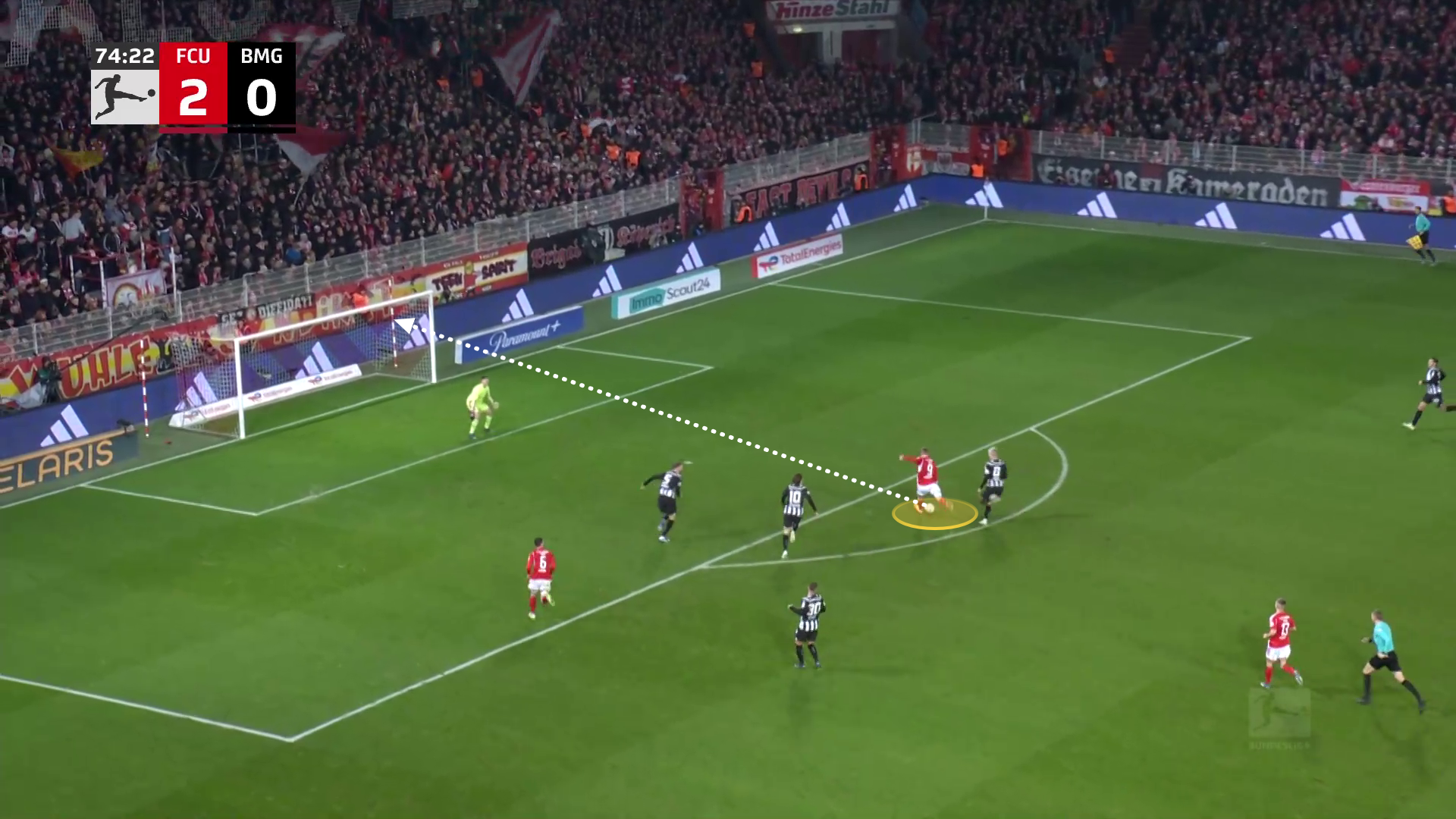
He then moves forward quickly, dribbling past one defender and instantly shoots from the edge of the box.
Kaufmann’s powerful shot is too strong for the goalkeeper to save, and he scores his first and only goal in the Bundesliga.
While Kaufmann is not the perfect clinical finisher Köln is looking for, he still is a great goalscorer and perfectly fits their high-paced playing style.
If he manages to improve his conversion of big chances inside the box, which he has all the talent to do, he could be the best striker 1. FC Köln has had in a long time.
Aune Heggebø – Pure Determination
The last player I would like to take a look at here is a player who looked like his career was spiralling into nothing just half a year ago.
Aune Heggebø is a young Norwegian striker playing for Brann in the Eliteserien and is now the top-goalscorer for the league-leading team just two matchdays before the end of the season.
Heggebø burst onto the scene in 2021, scoring eight goals for a struggling Brann side, but even a heroic performance in the relegation play-off could not save the club from relegation.
After relegation, the teams signed experienced striker Bård Finne.
After job-sharing in 2022, Finne took over the starting spot in Brann’s 4-3-3 formation in 2023, pushing Heggebø out of playing time.
With Finne scoring 16 goals and assisting 12 more in their first season back in the top flight, Heggebø only got 400 minutes of playing time and struggled big time.
With his career at stake, the young striker played convincingly in the first couple of games in 2024 as a joker, scoring multiple important late goals.
After three years, he finally got his starting spot back in the summer.
Ever since then, SK Brann has been unstoppable, currently sitting on a seven-game winning streak, storming to the top of the league and being the favourites to win the league with two games remaining.
Heggebø’s 11 goals put him in the third spot in the Eliteserien’s top-scoring list, but with way less playing time compared to the two Molde players at the top of the list.
At 1,85m and 84kg, Heggebø is a very physical striker, taking on a lot of attacking and aerial duels and playing in a very physical manner that is wearing on defenders every single game.
He is found everywhere on the pitch, doing all the dirty work, playing well as a target man up front, and trying to win as many duels as possible.
However, he also plays with high intensity on the far side of the ball, looking for openings and always making good runs into space to get open.
He also is a fox in the box, always knowing where the crosses and second balls will wind up, always finding space, and always being one step ahead of the defenders with his quick reactions, making him nearly impossible to defend.
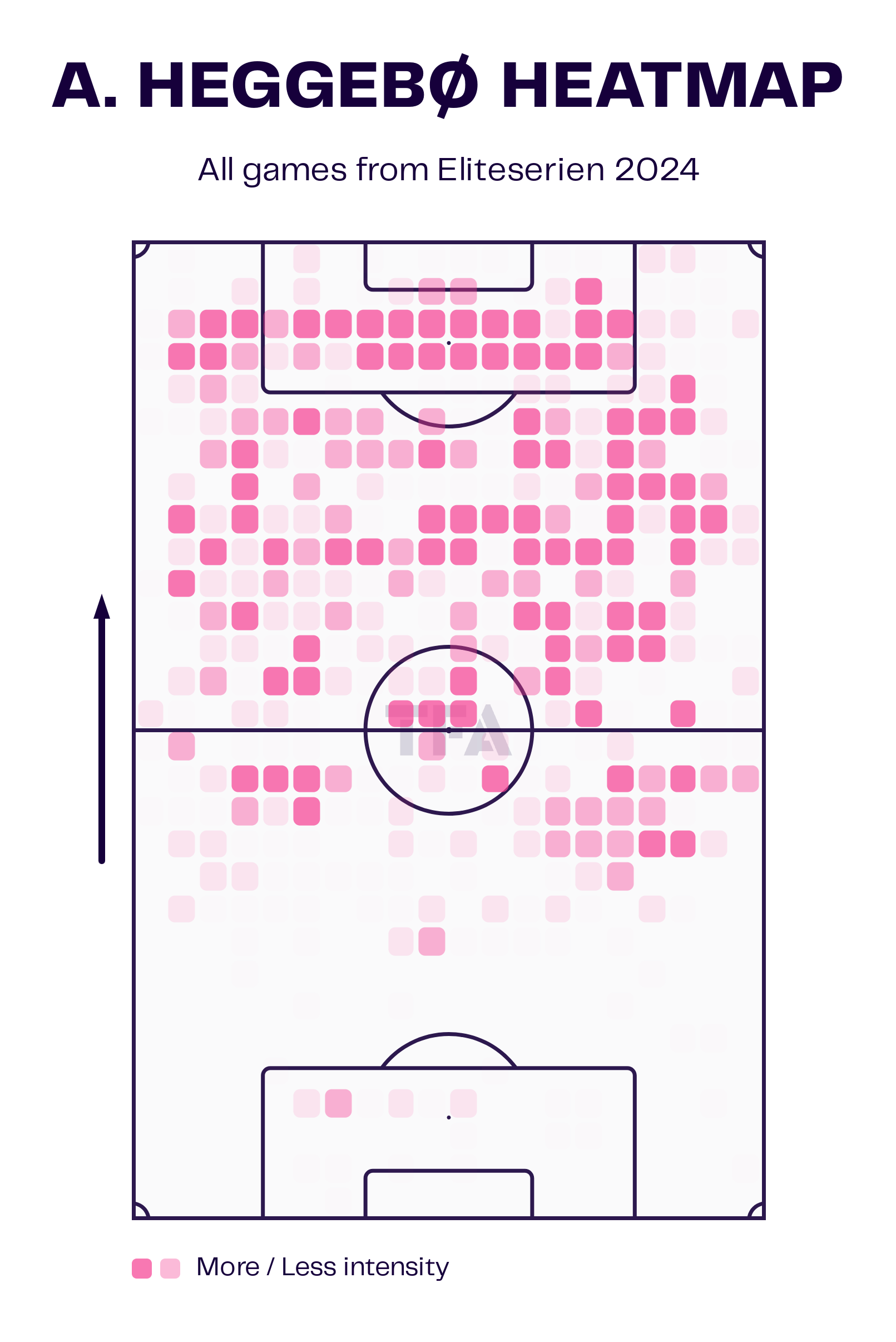
Looking at his heat map, we can see that, for a striker, Heggebø’s range of actions is really wide.
He is doing stuff everywhere on the pitch, but he still has a good presence in the box and as a target man in the half-spaces, especially on the right side.
We can also see that he is having a high intensity everywhere in the opposing half, making him so hard to defend, combined with his physicality.
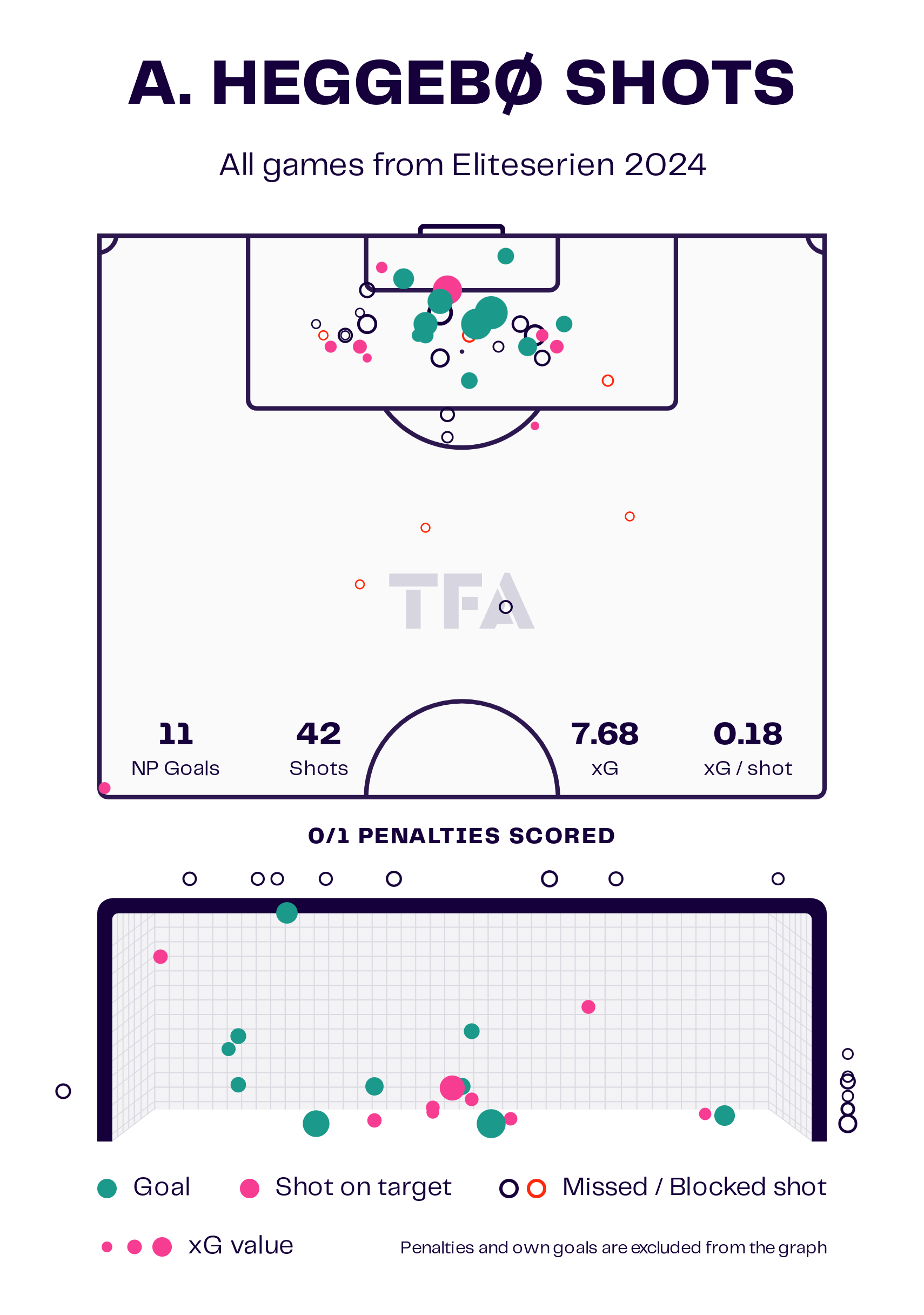
Looking at his shot map, we can see multiple important things.
Heggebø is finding a lot of shots in the centre of the box, where Struber and Köln are excelling at creating looks for their striker, especially around the penalty spot.
The Norwegian is able to covert these chances at a very decent rate and is able to at least put the shots onto goal in pretty much every situation. It is even able to convert rather small goalscoring opportunities.
Another important takeaway is that he is comfortably overperforming his expected goal value even though he missed a penalty.
11 goals out of 7.68 xG is very good for a young striker and just shows his excellence at finishing in the box.
Heggebø is also very both-footed, scoring a broad variety of goals with both feet and his head.
Although his shot placement is not ideal, he makes it work with good power and timing, making him a very good finisher overall.
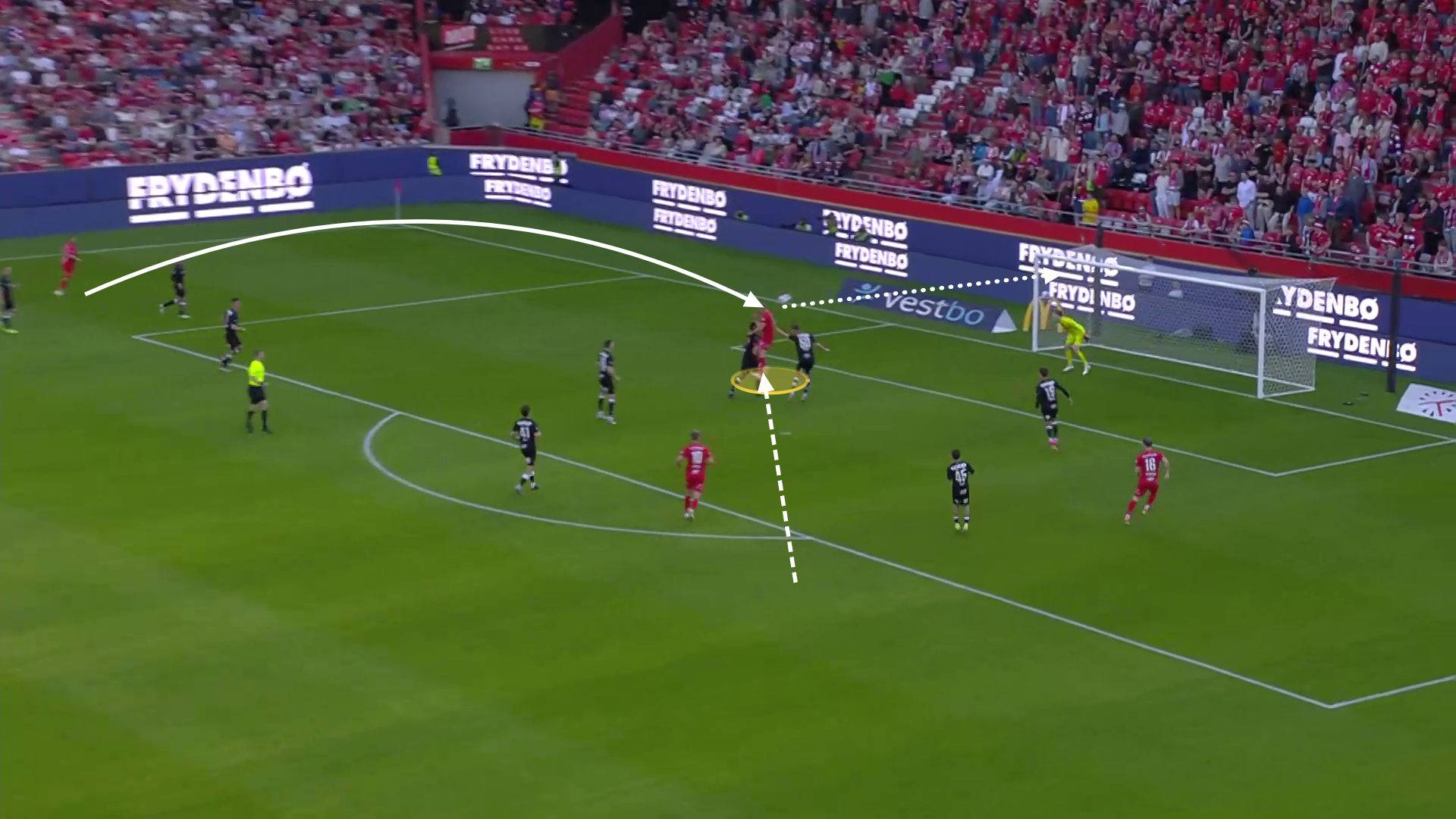
This goal just encapsulates everything that makes Heggebø such a threat and a joy to watch.
He moves to the far side of the ball and realises the crossing opportunity.
He instantly realises the space between the defenders in the box and makes a high-intensity run into that space.
He shows his athleticism with a great jump, beating out both defenders in terms of height and timing.
He can also apply a lot of pressure onto a very high cross towards the near post and head the ball into the goal.
This determination and the willpower to always do everything he needs to do to get playing time and score goals is what elevates Heggebø to another level.
He is a clever striker with good physical tools and decent finishing, but only in combination with his mentality is he becoming a striker who could be the X-factor for a team like 1. FC Köln in the 2. Bundesliga.
Conclusion
In this article, we now have looked at a couple of options for 1. FC Köln to sign in the winter transfer window.
While the team is playing extremely well, it lacks the last bit of determination to get over the hump and win their games.
While they are great at creating shots and goalscoring opportunities, their young strikers struggle with converting now.
While the five presented options are all different, they all would provide Gerhard Struber with an option up front that is capable of scoring goals and converting opportunities at a good rate.
Even after a disappointing start to the season, Gerhard Struber’s team is still within reach of the promotion places, and the club should do everything possible to strengthen it this winter transfer window.

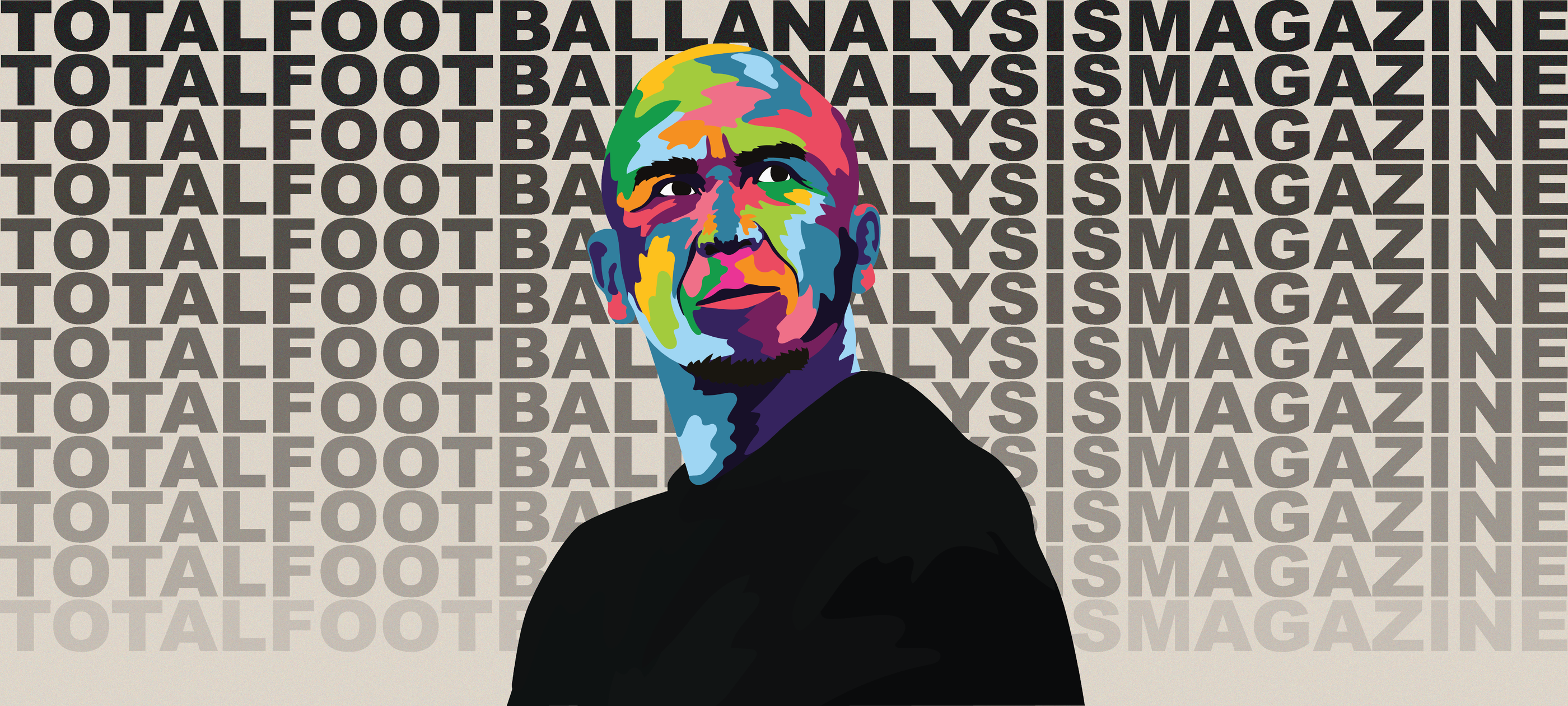




Comments